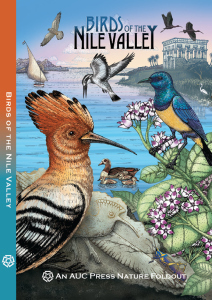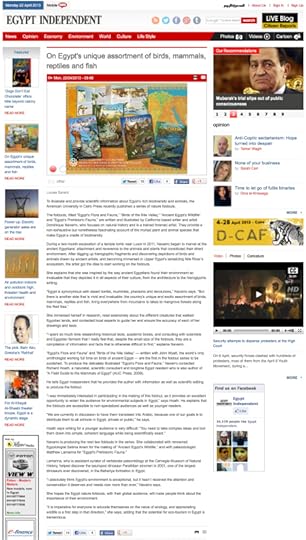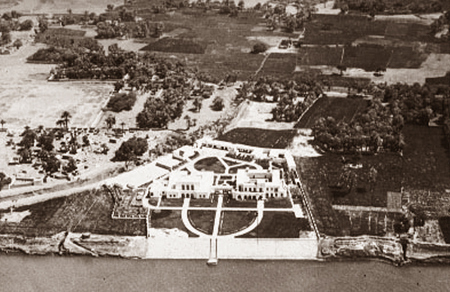Dominique Navarro's Blog, page 31
June 11, 2013
Goodreads Book Giveaway Contest for Birds of the Nile Valley; An AUC Press Nature Foldout
Filed under: AUC Press Nature Foldout Update Tagged: American University in Cairo Press, AUC Press Nature Foldouts, Birds, John Wyatt








May 16, 2013
In Passing – An Article by Richard Hoath for Egypt Today
As the spring migration winds down, the birding community remembers one of its most passionate environmental advocates
http://www.egypttoday.com/article/artId:1130/In-Passing/secId:47
By the end of this month many millions of feathered flypasts will have passed through Egyptian airspace from sub-Saharan wintering quarters heading for European breeding grounds, or will have left the country after having spent a relatively clement winter here. The latter will be fleeing the predicted summer heat.
This year’s migration, of which these bee-eaters are but a small part, will be the first in decades not to be witnessed by Mindy Baha El Din. Mindy, one of Egypt’s most passionate, committed and dedicated environmentalists, naturalists and above all ornithologists, passed away on March 21 after a short illness.
Filed under: Egypt Environmental News








April 24, 2013
Little green in Arab Spring – Egypt Independent’s closure a blow for environmental coverage
Last month’s closure of the Egypt Independent, a weekly newspaper and website, was a setback for progressive journalism in the region, but it has dealt a blow to coverage of environmental issues in a country still wrestling with major development questions in the wake of its revolution.
http://www.cjr.org/the_observatory/egypt_independent_environmenta.php
Launched in 2009 as an English-language edition of the privately owned Arabic daily Al-Masry Al-Youm, the Independent announced April 25 that its parent, Al-Masry Media Corporation, had decided to shut it down and squelch the final issue of the paper, which the editors published at Scribd.com instead.
Keeping with the Independent’s reputation for fearless coverage of the challenges facing post-revolutionary Egypt, the final issue focused on problems in the country’s media industry—its own demise chief among them. In a column that referred to her peers on the green beat as “endangered species,” environment editor Louise Sarant wrote:
For the past four years, the section’s journalists have reported in-depth on issues relating to political ecology, biodiversity, the preservation of native seeds, the struggles of farmers, habitat destruction, food sovereignty, energy, scientific discoveries, urban planning, solid waste management, industrial pollution, and the controversial drilling practice of hydraulic fracturing, while the rest of the Egyptian media has provided cursory coverage at best.
Some of the environmental violations are plainly visible but many other tragedies, such as destructive government policies, are less conspicuous and can easily go unnoticed. While kilometers-long oil slicks floating along the Nile are easy to spot, detrimental governmental policies are often unknown outside of ministerial offices.
Egypt Independent’s small but dedicated environment team has been committed since its inception to bringing into the public purview issues large and small that impact Egyptians and their environment.
For many Egyptians, the majority of whom live in rural areas, being able to access clean water, land to farm and resources to build a home, as well as natural resources and food security, are essentially what the revolution was about…
We believe the majority of Egyptians are less interested in who rules the country than equal and free access to the aforementioned resources required to sustain life, particularly when more than 40 percent lived below the poverty line of US$2 a day under the rule of former President Hosni Mubarak in 2009, according to the World Bank.
Filed under: Egypt Environmental News








In Egypt, environmental journalists are endangered species – Final Issue Article by Louise Sarant, Environment Editor
This piece was written for Egypt Independent’s final weekly print edition, which was banned from going to press. We offer you our 50th and final edition here.
Two months before word about Egypt Independent’s potential closure first surfaced, Noor Noor, executive coordinator of the NGO Nature Conservation Egypt, discussed the loss at stake.
“Egypt Independent is one of the only Egyptian media outlets that allocates staff solely to cover environmental issues in Egypt,” he wrote. “Environmentalists all across the world follow Egypt Independent for news and updates on environmental issues in Egypt. If anything was to compromise Egypt Independent’s ability to cover environmental issues, this would be an enormous loss, locally and internationally.”
Egypt Independent’s small but dedicated environment team has been committed since its inception to bringing into the public purview issues large and small that impact Egyptians and their environment.
One important feature in this section has been the endangered species series. Threatened local flora and fauna such as the African sacred ibis, the Egyptian tortoise and even various medicinal plants were featured to bring attention to their potential extinction.
However, now, as Egypt Independent receives news that this print issue will be its last under the leadership of Al-Masry Media Corporation, the series seems to have turned inward. It now appears that environmental journalism in Egypt has been shifted from the “vulnerable” to the “endangered” category.
Filed under: Egypt Environmental News








April 21, 2013
Egypt Independent Article on AUC Press Nature Foldouts by Louise Sarant featuring interview with Richard Hoath
Filed under: AUC Press Nature Foldout Update Tagged: American University in Cairo Press, AUC Press Nature Foldouts, Ecotourism, Richard Hoath








April 16, 2013
Reservoir of Riches – Egypt Today Article on Lake Nasser
http://www.egypttoday.com/article/artId:1114/Reservoir-of-RichesReservoir-of-Riches/secId:57
Lake Nasser is immense — what was once the land inhabited by the Nubians before the High Dam flooded the villages is today a unique sight that has so much to offer, its calm waters home to a magical ecosystem flourishing with plants, fish and animals in the middle of the desert. The scenery is incredible: clear waters, sand dunes and Pharaonic temples rising from a small hill as fishermen slowly float by on their small barques. On the leafy shores shepherds tend to their herds of sheep, a chorus of birds singing in the trees.
Filed under: Egypt Environmental News








April 9, 2013
In Praise of Rays – An Article by Richard Hoath for Egypt Today
Egypt Today’s resident naturalist muses on the winged wonders of the Red Sea’s underwater world
http://www.egypttoday.com/article/artId:1100/In-Praise-of-Rays/secId:57
The most frequently encountered ray in Egypt’s Red Sea is the aptly named Blue-spotted Stingray, a relatively small species at 90 cm in length (much of it a long and pencil-thin tail). It is a uniform olive brown in color boldly marked with the electric blue spots that give it its name.
Filed under: Egypt Environmental News








Egypt and Saudi Arabia sign the first executive program of bilateral cooperation in the environmental fields.
http://www.eeaa.gov.eg/english/main/allnews.asp?Article_Id=298
Pro. Khaled Fahmi, Minister of State for Environmental Affairs and Prince Turki bin Nasser bin Abdul Aziz, General President of Meteorology and Environmental Protection in Saudi Arabia, have signed the executive program between Egypt and Saudi Arabia, to promote cooperation and development of environmental relations between the two countries, in the framework of the ministerial meeting of the fifteenth session of the Council of PERSGA held in Saudi Arabia.
Filed under: Egypt Environmental News








April 1, 2013
IUCN Strengthening partnerships in Egypt
March 27, 2013
AUC Press Nature Foldouts at the Chicago House Library in Luxor
I was told today that the first two Nature Foldouts are being cataloged and added to the library at Chicago House in Luxor! I am so grateful to Ray Johnson, artists Keli Alberts and Susan Osgood and the librarian Marie Bryan. They’ve been so helpful and supportive to me throughout the project and development of the Nature Foldouts, and my research at the library has been invaluable.
New Chicago House shortly after completion in 1933, east bank, Luxor. Aerial photo by James Henry Breasted, Jr.
Filed under: AUC Press Nature Foldout Update






















